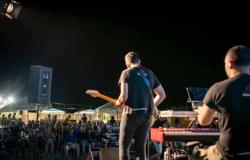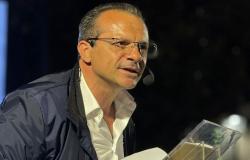In the suggestive setting of Piazzetta del Carro Trionfale, the solemn inauguration of the visits to the Fabbrica del Carro was held, with the official presentation of the Triumphal Chariot of the 2024 Bruna Festival. The event marks the opening of the 635th edition of the festivity and coincides with the 70th anniversary of the proclamation of Matera as Civitas Mariae.
The giant in papier-mâché
This year’s Triumphal Chariot, designed and created by papier-mâché master Francesca Cascione, represents a true masterpiece of art, faith and tradition. For the first time, in fact, the wagon presents two images of the Madonna della Bruna: the Holy Effigy on the throne and a papier-mâché statue created by the artist Francesca Cascione which dominates the rear part of the artefact. The work, which is inspired by the biblical theme of the disciples of Emmaus, is rich in symbols and suggestions, and represents an invitation to reflect on the mystery of faith and the strength of hope.
The presentation
The evening opened with religious messages from Don Francesco Di Marzio and Monsignor Pino Caiazzo, followed by the institutional greeting from the mayor of Matera Domenico Bennardi. Then the creators Francesca and Francesco Cascione spoke, illustrating the complex work of creating the wagon.
Monsignor Caiazzo then blessed the artefact, before its evocative presentation, curated by the light designer Carlo Iuorno. The presentation was accompanied by an intense theatrical performance, with the participation of Lucanian actors Giuseppe Ranoia, Erminio Truncellito, Angela Nicoletti and Emanuele Asprella.
The Triumphal Chariot will be open to the public until July 1st, from 9.30am to 12.30pm and from 5.30pm to 10pm. An unmissable opportunity to admire this masterpiece of art and tradition up close, and to fully immerse yourself in the atmosphere unique to the Bruna Festival.
The legend
Versions of the legend vary, but they all agree on some key elements. The most widespread tells of a farmer who, returning home from the fields, gave a lift to an unknown young woman. Once they reached their destination, the woman mysteriously disappeared, leaving the farmer an image of the Madonna.
The farmer, who went to the bishop, told what had happened. Together they went to the meeting place and found the image on a decorated cart. The news spread quickly and people flocked to venerate the Madonna. From that day, the image was carried in procession every year, giving rise to the Bruna Festival.
The origin of the name “Bruna” is uncertain. One hypothesis traces it back to the dark color of the Madonna’s complexion in the original painting, darkened by time and the smoke of the candles. Others, however, associate it with the provenance of the venerated icon, perhaps coming from Hebron, an ancient Jewish city.





